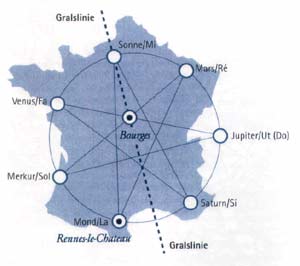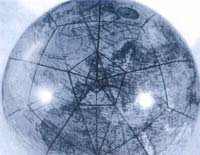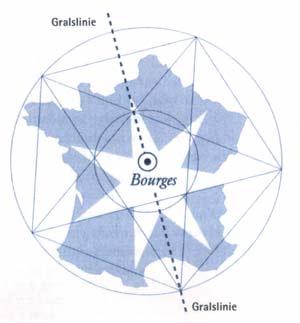|
||||||||
|
Alchemy & Paracelsus Medicine
The Path of the Energy of Life: The Secret Seven-pointed StarThe alchemical picture of the Vitriol seven-pointed star (septagram) reveals – like hardly any other picture – the deep knowledge of great alchemists such as Paracelsus. It shows their knowledge on the influence of the seven planets on and the course of life energy in the human being and even the living body of our earth.By Ulrich Arndt
In its centre the Vitriol seven-pointed star has a face to which
the two hands on the left and on the right seem to belong, and
the two feet as well. These four extremities refer to the four
elements: in one hand there is a torch representing the element
of fire, in the other hand there is an air bladder (Vesica Piscis)
representing the element of air; one foot stands on the ground,
and the other one in water. The fifth element is often overlooked
but sits enthroned on the very top as the double wing of Hermes.
The five symbols of elements are arranged in a regular pentagon.
Beside the feet a king and a queen are seated with the symbols
of Sun and Moon symbolising the polar powers of nature.
Upon this triangle there
is a circle with seven emblems and an inscription as follows: ”Visita
Interiora Terrae Rectificando Invenies Occultum Lapidem”,
in English: ”Search for the innermost of the earth, and you
will, by rectifying, find the secret stone.” The first letters
of all the Latin words form the name VITRIOL. In earlier times
Vitriol was already known as copper or iron vitriol from which
the alchemists made sulphuric acid for the processing of metals.
But Vitriol is as well an alchemical symbol for the process of
transmutation, thus meaning the legendary transformation from lead
to gold. Related to man this means his transformation from darkness
and disease to light, to health and to the dawning of consciousness.
This process is nothing but the mythical path to the Holy Grail,
since in the legends the Holy Grail stands for the achievement
of a ”purer” and ”more illuminated” respectively ”more
translucent” state.
The Knight Templars associated their seven-pointed star in France
very purposefully with the flow of life energy on our earth. Such
a sensational discovery was just made before the turn of the millennium.
Like Dawkins, the geomantist Siegfried Prumbach has found extensive
energy lines. Four years ago he discovered that all these ley-lines
form a regular geometrical pattern: a global energy grid that is
mainly built by 12 large pentagons, forming a so called dodecahedron
(one of the five Platonic solids). Exactly in the centre of one
of these large pentagons which is superimposed on Europe and North
Africa, Bourges is located as the centre of the seven-pointed star.
And, the line of the Grail too, runs exactly through the centre
of this pentagon.
The secret knowledge of the alchemists is in regard to the way the energies in the seven-pointed star of the planets are to flow in order to have a vitalising effect. They knew how to transform the ”dark planetary order” of the Nigredo level to ”gold” and to brightness. They called this highest level of vibration ”Rubedo” (= reddening), according to the colours appearing during the transformation of matter in the Great Work. The endeavour of all great alchemists was to reach this highest level of vibration in their laboratory work and within themselves. For this purpose Paracelsus transformed solid metals and gems into unique lucid elixirs. Used as remedies they are meant to ”brighten up” man in the same manner, i.e. to raise him in his vibrational level, and to heal and support the development of character and consciousness. Bildquellen: ©Hans Nietsch Verlag, ©Siegfried Prumbach 1x
|
|||||||||||||||||||
Für weitere Informationen beachten Sie auch die Partnerlinks
Bitte beachten Sie:
Die Informationen dieses webs sind journalistische Aufbereitungen des
jeweiligen Themas und ersetzen keine medizinische Beratung. Bei
gesundheitlichen Problemen und Erkrankungen suchen Sie bitte zuerst einen
Arzt oder Heilpraktiker auf. |
|
|
| |
Home |Impressum |Datenschutz | Links | Bücher
& Seminare | Suche | | Heilmittel | Alchemie | Diagnose | Therapien | Selbsthilfe & Ernährung | Spiritualität & Wissenschaft | Urwissen | Denken & Handeln | Freizeit | |
| © horusmedia.de Ulrich Arndt Rechtliche Hinweise |
|
Bitte beachten Sie: Die Informationen dieses webs sind journalistische Aufbereitungen des jeweiligen Themas und ersetzen keine medizinische Beratung. Bei gesundheitlichen Problemen und Erkrankungen suchen Sie bitte zuerst einen Arzt oder Heilpraktiker auf. Ausdrücklich sei zudem darauf hingewiesen, dass in Artikeln eventuell beschriebene Methoden, Therapien, Hilfsmittel und Nahrungsergänzungen lediglich Hinweise und Verfahren einer alternativen, esoterischen oder traditionellen Erfahrungs-Heilkunde darstellen und keine Heilmittel und anerkannte Therapieformen im Sinne der heutigen Schulmedizin sind. copyright - Urheberrecht Rechtliche Hinweise Die Urheberrechte sämtlicher Texte liegen, sofern nicht ausdrücklich anders gekennzeichnet, bei Ulrich Arndt (im Folgenden der Autor genannt). Inhalte dürfen nur zu Informationszwecken und nicht zum Verkauf oder zur Verbreitung zu gewerblichen oder politischen Zwecken verwendet werden. Kein Artikel, kein Auszug aus einem der Texte, keine Grafik oder Bild dürfen ohne schriftliche Zustimmung des Autors in irgendeiner Weise vervielfältigt, verbreitet oder öffentlich wiedergegeben werden. Ohne schriftliche Einwilligung des Autors dürfen die Datenbank oder Teile von ihr auch nicht in von Datenverarbeitungsanlagen verwendbare Sprachen übertragen oder übersetzt werden und dauerhaft gespeichert. Ausgenommen hiervon sind nur Vervielfältigungen, die technisch zum Zwecke des Einblicks in die Datenbank unumgänglich sind und nur vorübergehend vorgenommen werden. Die Urheberrechte an Bildern und Grafiken liegen manchmal beim Autor, manchmal bei den Zeitschriften, in denen die Artikel erschienen sind, oder bei Dritten. Jegliche Nutzung bedarf der schriftlichen Zustimmung des jeweiligen Rechteinhabers. Der Autor behält es sich ausdrücklich vor, Teile der Seiten oder das gesamte Angebot ohne gesonderte Ankündigung zu verändern, zu ergänzen, zu löschen oder die Veröffentlichung zeitweise oder endgültig einzustellen. Markenrecht Alle in Artikeln eventuell erwähnten Marken- und Warenzeichen unterliegen uneingeschränkt den Bestimmungen des jeweils gültigen Kennzeichenrechts und den Besitzrechten der jeweiligen Eigentümer. Verwendungen bedürfen der schriftlichen Zustimmung des Marken- und Rechteinhabers. Links Einige Seiten dieser Website enthalten Links zu externen Websites. Diese Links ermöglichen Ihnen den Zugang zu weiteren Informationen bestimmter Themen. Trotz sorgfältiger inhaltlicher Kontrolle zum Zeitpunkt der Verlinkung übernimmt der Autor keine Verantwortung und Haftung für die Inhalte externer Links. Für den Inhalt der verlinkten Seiten sind ausschließlich deren Betreiber verantwortlich. Haftungsausschluss Der Autor hat die Informationen der Artikel nach seinem Stand des Wissens zum Zeitpunkt der Entstehung des Artikels und mit journalistischen Sorgfalt erstellt. Sollten sich dennoch unvollständige, fehlerhafte oder illegale Informationen eingeschlichen haben, so bittet der Autor um Entschuldigung, übernimmt aber keinerlei Haftung. Mit den Artikeln dieser Website sind keine Angaben und keine Gewähr zur Eignung der darin enthaltenen Informationen für einen bestimmten Zweck verbunden. So übernimmt der Autor keine Gewährleistung und Haftung im Zusammenhang mit jeglicher Nutzung der Informationen auf dieser Homepage, und in keinem Fall kann er haftbar gemacht werden für besondere oder indirekte Schäden, Folgeschäden, entgangenem Gewinn oder sonstige Handlungen, die aus Nutzung der Informationen resultieren. Sofern Teile oder einzelne Formulierungen dieses Textes der geltenden Rechtslage nicht mehr oder nicht mehr vollständig entsprechen sollten, bleiben die übrigen Teile des Dokuments in ihrem Inhalt und ihrer Gültigkeit davon unberührt. |
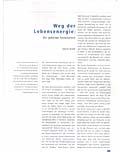

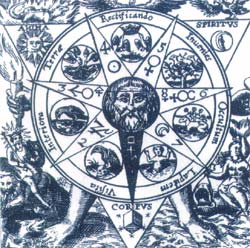
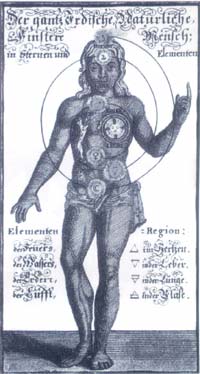 Planetary
man, by Gichtel. The seven planets mark the ”furnaces of
the soul”, as the alchemists called the seven chakras.
Planetary
man, by Gichtel. The seven planets mark the ”furnaces of
the soul”, as the alchemists called the seven chakras.